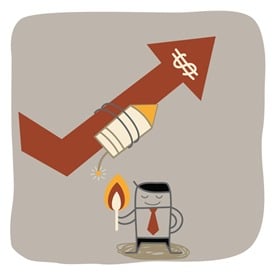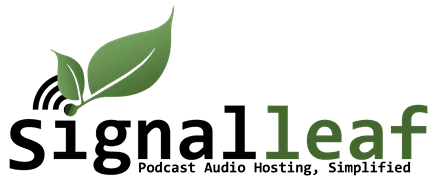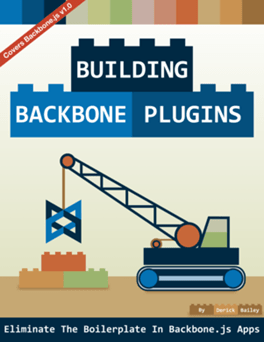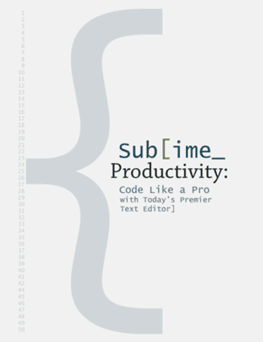You are dropped in the middle of the forest by helicopter with nothing but a hunting knife. What do you do? How do you survive?
That was the basic premise of the challenge a couple of my buddies and I undertook, only instead of our competition taking place in the woods, ours took place completely online.
The idea was pretty simple. You have one day–24 hours–to make at least $100 online. The only catch is you can't use anything you have already. You can't use your Twitter account, you can't use your blog, you can't sell some product you already created; whatever you do, you have to do it within 24 hours and you have to get cold hard cash–I owe yous don't count.
This is the first in a series of three blog posts that are going to detail the events of this story from each of our perspectives.
- In this first post, Josh Earl, Derick Bailey and myself will talk about what we thought about prior to the contest, how we felt and prepared mentally, and what we planned to do.
- In the next post, we'll each talk about what actually happened when the clock ticked midnight on Dec 17th, 2013. And how we survived the 24 hour ordeal.
- Finally, in the last post, you'll hear the final outcome of the competition as we each discuss our results, break down what exactly we think we did right and what we did wrong, and how we would have done things differently.
My story

I've worked for large and small companies, worked as a contractor and an employee and used a wide variety of programming languages and technologies, but my true passion has always been teaching.
A few years ago I started making courses for Pluralsight and during that time I produced 54 courses on everything from Android and iOS to game development. The success from this venture allowed me to quit my job and work full-time on my own company, Simple Programmer. Since then, I've been writing blog posts, making YouTube videos, creating podcasts and producing products to help developers in all areas of their life.
The challenge
I have to admit, I was a bit intimidated by the challenge–even though I was the one who proposed it. It is one thing to talk about making $100 online in 24 hours–it is another thing to try and do it.
I felt pretty confident that I could easily accomplish this goal right up until the point that we actually set a date on the calendar and committed to doing it.
One of the rules we had set out was that we couldn't actually write down anything or do any prep-work ahead of time–it all had to be in our heads. I figured that I had better come up with some idea of a plan, so I started thinking about some of the possible ways that I could earn $100 in a day.
One obvious way was just to start randomly begging people for money. Explaining the contest itself was not against the rules, so I could basically pitch people by telling them I wanted to win this contest and see if they would contribute. I was pretty sure in 24 hours I could talk to enough people to scrape together the money, even if I had to do it one dollar at a time, but that idea didn't really seem too appealing to me. I wanted to do something for this contest that would have the potential of benefiting me in the long run. (I did stash this idea as a last resort to use in the case that my main plan failed though.)
The next idea I had was to do some kind of affiliate marketing. At the very least I could try and market some Amazon products and get a 6% commission on whatever I sold. But, I could also find some other high commission product and try to sell it. The problem with this approach would be that I wouldn't really have any audience to sell into; I'd basically have to be like a door-to-door salesman randomly posting on forums and Facebook groups trying to make a sale. Also, it wouldn't have any long term benefit to me. This option seemed viable, but I thought there had to be something better I could do.
My next thought was to create a small product that I could sell. I thought perhaps I could put together a small eBook that was somewhere around 5,000 to 10,000 words and put up a small website to sell the eBook. The only problem with this approach would be that I would have to spend a large amount of the day writing the eBook and then I'd have to try and get traffic to my sales page. But, at the end of the day, I'd actually have a product that I could sell and improve in the future. This idea seemed promising, but how was I going to write a book in a single day and still have time to market it, and what should I price something like this at?
The product
I had a couple of weeks until the competition, so I spent some time during my running workouts thinking about my strategy. I was pretty sure I was going to create some product and try to sell it, but I wasn't sure exactly what kind of product I should create and how I should price that product.
One thing that occurred to me pretty early on was that I if I sold something at a low price, I'd have to make a large number of sales, but if I was able to create a product that I could sell at a high enough price, then I could possibly reach my $100 goal just by making one or two sales. It seemed that it made the most sense to try and sell a high-priced item, since there wouldn't be enough time to do enough marketing to get the traffic needed to sell a bunch of little items. But how the heck could I make something in less than 24 hours that I 
It turned out that I had already planned to create a course that was going to teach developers how to market themselves in order to get better jobs and boost their careers. I had come up with this idea, because I had realized how valuable the publicity I had gotten from my blog, podcast, and Pluralsight courses had become to my career, and I felt that I could condense the information I had learned from this experience into something that just about any other developer could recreate. The only problem was that I had planned to create this course the following year and the course was going to take a long time to create–we are talking months, not weeks.
Then, I had a brilliant idea! What about preselling the course? I could create a first draft of one of the eBooks for the course and give it away within 24 hours for anyone who bought the presale of the entire course. If I told the customers who prebought the course that they'd get the eBook within 24 hours of their purchase, it would actually even buy my an additional 24 hours to create the book. (None of this was against any of the rules for the contest, since I would be getting the money during the 24 hour period, even if I delivered the goods later.) It was a bit risky–I mean, I would still have to write an entire first draft of a book in about 24 hours–but I thought this was the best chance of selling a high priced item. As an added bonus, all the work for the competition would force me to actually create the product I had been planning to create the next year and would actually give me a head-start on doing it.
The strategy
Next up was trying to figure out exactly what I was going to do tactically to get this product up for sale and to make the best use of my 24 hours. I had to do quite a bit of running and rehearsing in my mind, but I came up with what I thought was a solid plan.
I decided that I should probably go to sleep really early the night before the competition and try to wake up right around midnight in order to maximize the amount of time I had to actually create and sell my product–this was pretty obvious and I expected my competitors to do the same.
Then, I started thinking about what order I would probably want to do things. It seemed to me that I wanted to have as much time as possible to market the product and have the product for sale, so the first priority would be to stand up some kind of a landing page and make the product available for sale as soon as possible.
But, the real big problem was how to market this thing. What do you do when you only have 24 hours and you can't use your existing social platforms? If I could send an email out to my email list or make a post on my blog, this would be easy, but starting from scratch and only having 24 hours makes this rather hard. I thought about some of the things I could do to spread the word.
One obvious thing would be to email other developers that I knew, whom had big audiences, and see if I could get them to mention my product on their social networks. I thought I could probably come up with a pretty large list of developers that might be willing to help me out and I could send out one email to all of them, which would leverage my time effectively.
Another idea I had was to write up some kind of epic blog post that I could get on Hacker News or Reddit. I would have to create a brand new blog to do this, since I couldn't use my existing blog, but if I was successful, it could generate quite a bit of traffic to my landing page and with enough traffic, I should be able to get the few sales that I would need.
I also considered that I could post in various developer forums and communities. I could either answer posts or create my own post that would have some relevant information, but eventually lead someone to my landing page. It would be another way to extend my reach by borrowing another audience.
Finally, I thought as a last resort I could purchase a list of developer email addresses and send out a one-time email blast to try and sell the product. It might be perceived as spam, but if I could send out an email to a large enough list of developers, I would at least be able to make a few sales.
I had to keep thinking about this list of marketing ideas in my head so that I wouldn't forget them before the contest, since I wasn't allowed to write them down.
So, that is it. That was my plan. I was going to create a landing page for my How To Market Yourself as a Software Developer course as quickly as possible and try to market it mostly by leveraging existing audiences since I couldn't use my own. I felt like it was an OK plan, but I still had some serious doubts and reservations about my ability to pull it off.
It might not sound like much, but this challenge was daunting to me. Sure, I've earned hundreds and even thousands of dollars in a single day with screencast releases, book sales and other things. But having to do this in a single day, using no existing assets or networks… I'm getting that tight chested, stomach churning fear just remembering it.
Derick Bailey’s Story

Deciding What To Do
We talked about this a number of times before we set the date, and in those discussions I decided that I was going to focus on my SignalLeaf service for this day. Yes, SignalLeaf was something that I had already started, but it had next to nothing in terms of traffic and network. There were only a few followers for the @SignalLeaf Twitter account, there was next to no traffic on the blog (a blog that barely had a post or two on it) and the site was not getting any significant use. John and Josh both graciously agreed to let me focus on SignalLeaf since anything else would potentially mean starting up a new business model or finding a one-time thing to do. I wasn't really interested in finding a new business model, though the one-time-only idea had me interested.
Creating A Plan
After getting SignalLeaf approved by the other guys, I made a plan in my head for what I was going to do. I would focus my day on creating and selling an eBook on how to get started in podcasting. I wanted to help people get past their fear of starting, their fear of failure and their constant delay tactics. I wanted to show people how easy it is to get started in podcasting, and give people a clear path to getting their first episode online. An eBook seemed like a great way to do this, and I've had a lot of success with my Building Backbone Plugins eBook. So that was set. The eBook would be my majority focus for the challenge day.
But after I settled on the eBook, I thought of something else… something a bit devious and underhanded. In addition to the eBook, I decided I was going to build a website that quite literally asked people to give me money just so I could win this challenge. I would buy a domain name on the day of the challenge, stand up a very simple page with a PayPal donate button and find a way to get people to it. Since we couldn't use our own existing blogs or social networks, though, my plan was to borrow someone else's. I was going to email a few very well known developers and friends, and beg them to tweet a link to my new site. It was sneaky, dirty fighting and totally sounded like something worth doing just to win.
So the rough outline for my day, with both an eBook and website to build, would be:
- 12am (Midnight): wake up and get breakfast
- 1am: buy a domain name for the “give me money” site
- 2am: publish the site
- 3am: start writing the eBook on podcasting
- 12noon: publish whatever I had on Leanpub.com, and build the marketing page
- 1pm: begin marketing the book through any means I could think of
- 12am (midnight – 24 hours later): get one final report of any income I had earned that day
Awesome. Plan set. Wife and kids informed, and vacation day from work scheduled. Now, I wait for the day to come.
The Mounting Fear
As that day got closer, I became more and more fearful – fear of failure, fear of being laughed at, fear of having someone call me out and tell me I'm a fraud or some kind of marketing shill just begging for money. It was terrifying, and I let that fear get to me. I continued to make my plans in my head. I thought about what the eBook would say. I considered ideas for building the “give me money” page. I wondered about how I would email people about it. But all the time, while I was thinking about these things, I felt my stomach turning in circles and tying in knots. The closer the day got, the worse I felt.
Honestly, I wanted to give up even before I started. I thought about the book I was going to write and whether or not I could even market and sell the thing. I wondered about the viability of selling a book on podcasting when there are so many resources for getting started in podcasting already. I even sent an email to Josh and John expressing my concerns about being able to sell this. The fear was killing me, and I wanted to give up. But I didn't and I'm glad I didn't – not because I was successful, but because of the things I learned from that day and the effort I put in to it.
So It Begins
The experience of throwing yourself in to the woods with nothing more than a knife is terrifying – even more so when you know it's coming. So I went to bed early and tried to sleep, with my brain running wild with ideas, keeping me awake longer than I should have been. Then my alarm clock went off and the day was here. I pulled myself out of bed and got to work.
Josh Earl’s Story

Challenge accepted…
When John first proposed this challenge, it sounded like a blast. Take a vacation day, spend some time hacking on a business idea, taunt friends via email, make some money. What fun.
And even better, I thought I had a decent shot at winning.
I have a little experience doing business online. I've published and marketed an ebook about Sublime Text that’s earned nearly $20,000, created several blogs that receive thousands of hits a month, and started a niche site that earns hundreds of dollars a month in Amazon affiliate income. I've built a collective Twitter following of nearly 13,000 and a mailing list subscriber base of more than 5,000.
I've also enjoyed some success with generating “instant traffic” for my sites. I've had four posts featured on LifeHacker and another half dozen or so that spent a few hours on the front page of Hacker News.
Once the battle lines were drawn, my plan coalesced quickly.
I’ve proven to myself that I can get traffic quickly, so I decided to play to that strength. If I could get enough traffic, I knew I could figure out a way to convert that into money.
What could I create that would generate thousands of visits?
The answer was obvious.
There's a blog post I'd wanted to write for ages, It was going to be a behind the scenes look at how I'd grown my audience and my income in the year since I published my book. I'd be as transparent as possible and share what I'd done well and where I'd fallen short. Then I'd wrap it up with a summary of some of the lessons I've learned over the past year.
The web loves these posts—Pat Flynn built much of his following around his monthly income reports, and Amy Hoy and Nathan Barry have also used them to good effect.
I had a good story and inspiring results, and I knew if I wrote the post it would be popular.
I decided to bet the farm on this blog post. I’d invest whatever time was necessary into writing and promoting it, then spend the rest of the day figuring out how to earn a few bucks from the torrent of traffic.
I had several ideas that I hoped would increase my chances of hitting a home run. First, Hacker News. A post that lands on the front page will receive dozens or even hundreds of page views a minute. I thought I could engineer a front page hit if I posted early enough in the day (7 a.m. Eastern in the U.S. is primetime). To maximize the appeal of my post, I planned to study several examples of income report-type posts that had done well on HN and use their headlines and structure for inspiration.
Second, I'd be as open and honest as possible about my successes and struggles. This post would be genuine and informative.
Third, I planned to mention well-known people who contributed to my success, giving me an excuse to reach out to them directly via email or on Twitter and ask them to share the post with their larger audiences.
To summarize my traffic generation strategy, I planned to write a killer post in a genre that I knew was popular with a specific audience, then try to borrow other people's audiences to help me get the word out.
But how could I generate income from this traffic?
If there's one thing I've learned in the past year, it's that email is the best tool for selling products online. From my experience marketing my Sublime book, I've learned how to use a free giveaway as an incentive to get people to sign up for my mailing list, and I've also learned how to get people to open and read the emails I send.
I planned to use the same tactics that I've used effectively to market my book—only this time I’d do it at warp speed. At the end of my post, I'd entice readers to join my newly created mailing list by offering a useful giveaway. This “lead magnet” would be something related to the post—maybe a list of tools that I've relied on to create and market my book.
That meant I'd need to create the giveaway and write an email welcoming people to my list and linking them to the list of tools. I knew from experience that this email would get a very high open rate. I also knew that adding a P.S. to an email is a great way to draw attention to a message—after the subject line, it’s the one thing most readers will see. So I’d use a P.S. in the welcome email to promote whatever product I decided to offer.
Oh, yeah, that.
What in the world could I sell?
In addition to the contest rules, I had a self-imposed constraint that limited what I could offer: I didn't want this product to require much of an ongoing commitment after the contest ended. That meant that preselling a book was out—at the time, I was hip-deep in editing my next Sublime Text book, Writing Sublime Plugins. The last thing I needed was another massive writing project to feel guilty about.
Two ideas seemed to fit: I could offer to let people book some time with me for one-on-one marketing help, or I could sell seats to a Google+ Hangout where I delved deeper into how I've promoted my book. I wasn't sure which option I'd go for–it partly depended on which was easier to set up. I’d need to do some research into scheduling and event software, and I couldn’t do that in advance.
It seemed like a sound strategy. I looked at it as a math problem. If I could get several thousand page views on my blog post, I could probably get 100 people to sign up for the mailing list. From that, it seemed reasonable that I could sell four to six seats or coaching sessions for $20 to $30.
The entire day was going to be an exercise in creative prioritization and creating and shipping things just in time. Here's how I envisioned the day unfolding:
- 5:00 – 7 a.m. — Research blog post format. Outline and write post. Set up mailing list subscription form.
- 7:00 a.m. — Publish post. Post link on Hacker News.
- 7:00 a.m. – 12:00 p.m. — Promote post via email, Twitter.
- 1:00 p.m. – 3:00 p.m. — Decide on product format. Write sales page.
- 3:00 p.m. – 5:00 p.m. — Create list signup giveaway. Write and send welcome email, including giveaway and event promotion. Schedule welcome email to go out automatically to new subscribers.
- 7:00 p.m. – 9:00 p.m. — Find additional ways to promote blog post. Try to sell event or coaching slots directly to friends and acquaintances.
My confidence started to ebb as December 17 got closer
Instead of looking forward to the contest, I started to dread it.
There were two main sources to this stress. One was the reason why I hadn’t already written this blog post, and the other was a fundamental fear that most humans suffer from.
As I mentioned earlier, this blog post idea had sat in on my to-do list for months. I’d resisted acting on it even though I knew it would be a hit. Why the reluctance to do something I knew would be good for my business?
The very thought of publishing this post made me feel like fraud. While I've had some modest successes with my marketing efforts, there are a lot of people out there who know a lot more about the topic than I do. I've learned most of what I know from sources like Amy Hoy’s 30×500 class and blog posts from guys like Nathan Barry and Pat Flynn. I was afraid of what these marketing vets would think. Would they just laugh at me and leave sarcastic comments?
Then there was another terrifying possibility: If my post did well and I sold a few seats, I’d have to gulp speak to a group of people—and purport to know what I was talking about. And for me (as with most breathing humans), public speaking ranks up there with swan diving into a pit of rattlesnakes.
The fear intensified with each passing day. I knew I had a shot at winning this contest, but by the time I went to bed on December 16, I wasn’t sure I wanted to.
Up next
In the next post in this series, you’ll hear from each of us how each of our days actually went. So, stay tuned. Subscribe here if you don’t want to miss the updates.







